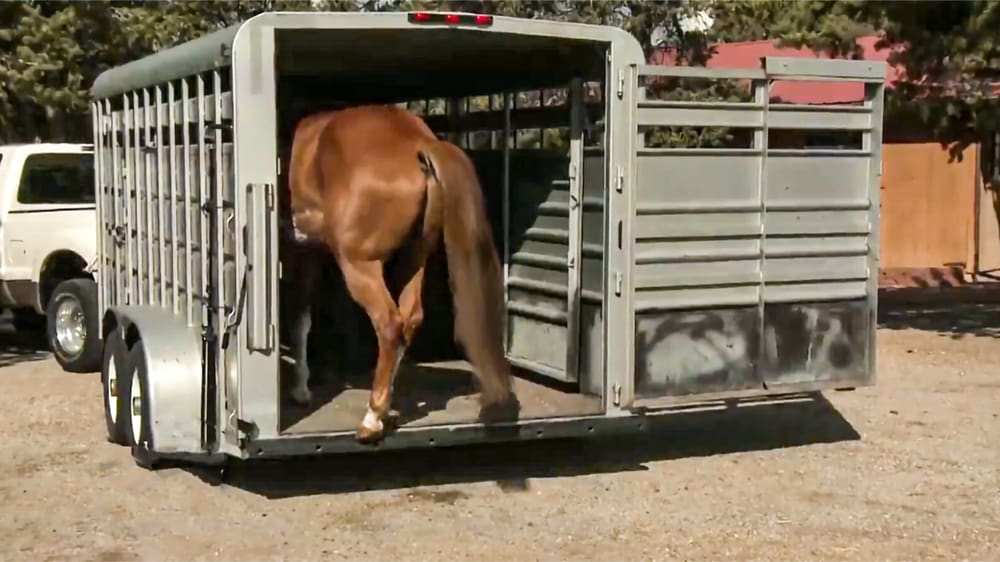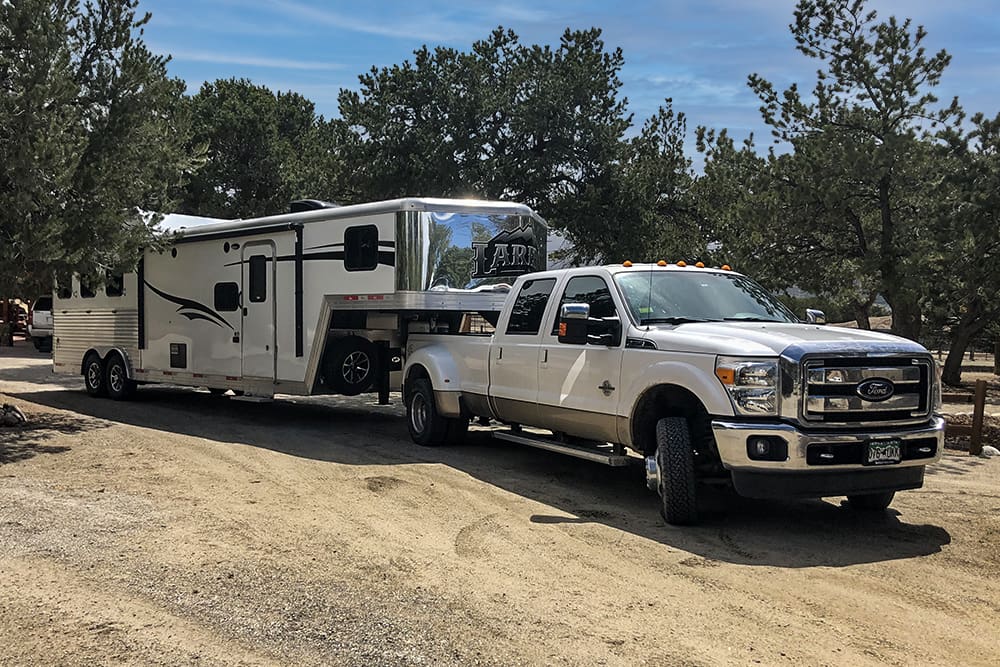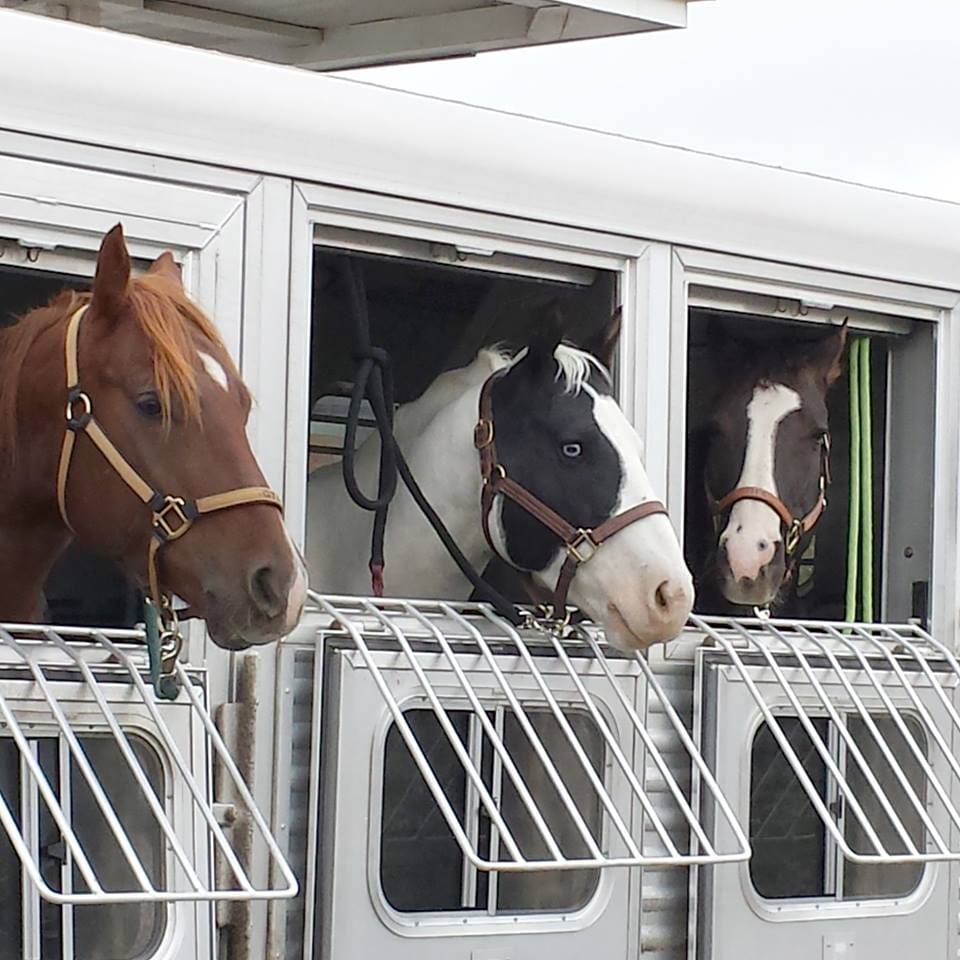
It’s been a lot of fun to hear about the goals, skill assessments, and training plans that we’ve all been working on this year in our Horse Goals or Bust! endeavors. Hopefully your plans are coming together, and you are ready for the doing—whatever that looks like for you and your horse.
For many of us, our goals for this riding season involve going somewhere with our horses. Travel logistics are almost a daily part of my life, as I run from coast to coast, from one event to another. Decades ago, I decided not to subject my horses to the grueling travel schedule I chose for myself. So for the most part, now I hop on a plane and ride a horse provided for me at the destination. Still, I have plenty of opportunities to travel with my horses, be it for a trail ride, a clinic at the C Lazy U Ranch, or a regional horse expo.
Making a trip with your horse is usually fun, but towing your precious cargo behind can entail a certain amount of stress.
Click Here for Some Trailering Resources That May Help
Over the years, as I talk to people at horse expos and horsemanship clinics, as well as from listeners of my podcast, there are certain questions from horse owners that come up again and again. Often these questions involve trailering horses, ranging from loading/unloading problems to how to keep your horse comfortable on the trip.
This month, I’m answering some of the most frequently asked questions in the hopes that you’ll find the piece of info that makes your upcoming trips safer and more enjoyable for both you and your horse!

Ready to Ship Today! (719) 530-0531
Question #1: What do I need to do to get my trailer ready for the road?
Safety always comes first, so make sure you stay on top of trailer maintenance. Maintenance should be done well in advance of any trip you make, and thoroughly inspected by a mechanic who is knowledgeable about horse trailers at least on an annual basis
- Tire tread and air pressure—including the spare
- Flooring
- Wiring
- Lights
- Grease the bearings
- Test the trailer brakes and emergency brake
In addition to a basic tool kit, I also carry wheel chocks and a heavy-duty floor jack so a flat tire can be changed without unloading horses on a dangerous roadway.
Consider installing a surveillance camera inside your horse trailer so you can keep an eye on that precious cargo while underway. There are great kits made just for this purpose that you can buy, or you can get one from an electronics store, or use a portable back-up camera that will Bluetooth right to your phone. My truck has built-in camera capabilities for multiple cameras which display on the dash (front, back, side, and inside the trailer). To me, this is a major safety feature and one of the primary reasons I bought a Chevy for my hauling truck.
The day before my trip, in addition to loading all our gear (keep a checklist), I prepare the trailer for my horses. Good ventilation is the most important thing—especially in warm weather. In an enclosed trailer, there should be an opened roof vent directly over each horse and I also crack or open most windows, making sure the airflow is directed back and out (not swirling). Trailers can get extremely hot for the horses, as heat comes up from the road and the horses’ body heat accumulates.
Avoid putting much hay or shavings in the trailer, which may fly around causing poor air quality and irritate your horse’s eyes. Don’t hang a hay net right in front of your horse’s face in a slant load trailer—it can be very intrusive and crowding, not to mention cause more dust and debris to fly in its face. A horse likes to have space in front of its face. I only put a small amount of shavings under the rear-ends of the horses to soak up any urine to prevent slippery surfaces. It’s doubtful your horse will be laying down—it doesn’t need bedding.
I carry fully loaded hay nets that are easily available in a compartment. Then, every time we stop, I can open a side door of the trailer and hang the nets on the side of the trailer so my horse has a snack and some fresh air. If your trailer has a manger, it’s okay to put some hay in there—just don’t over stuff it, and consider all the issues mentioned above. I also carry lidded, 5-gallon buckets in the trailer with water from home, but remember, you can lead a horse to water….

Ready to Ship Today! (719) 530-0531
Question #2: How do I prepare my horse for the trip?
Hopefully your horse is a seasoned traveler and walks straight into the trailer without hesitation and backs out slowly and carefully upon arrival at your destination. If you hesitate to answer yes, it will be well worth your time to do some training. With my trailer loading techniques, your horse will load willingly and stay in place as you close the doors. Sometimes horses load fine but are afraid (understandably) to back off the cliff on the way out. My video on trailering covers these subjects thoroughly, as well as safely driving your rig (including how to back up easily!), and trailer safety checks.
If your horse is new to trailer loading, or if you’ve developed loading issues, plan to spend two or three weeks ahead of your trip to follow my training steps. Teaching your horse to willingly load in the trailer will happen very fast, but you’ll need daily practice and to feed the horse in the trailer for a week or so to make sure its comfort level and confidence are high.
The two of the most common questions I get on trailering horses have to do with leg protection and whether or not to tie the horse inside the trailer. You’ll get plenty of different advice on these subjects, so the best I can do is tell you what I do and explain why.
I do not use leg wraps or shipping boots on my horses in the trailer. My horses ride very quietly in the trailer, like seasoned pros, leaning on the padded supports and hardly moving a foot during the ride (I can tell by the condition of the trailer floor when I get there). I don’t find it necessary, and boots can make the horse hot and uncomfortable. Worse, if a boot or wrap slips down during the voyage (as they are prone to do), it can cause more problems than it solves.
If I am hauling a horse that has circulatory issues or swelling in the legs, I might use standing wraps that support circulation. On rare occasions when I am shipping a horse cross-country and it will be on the truck for a few days, I sometimes duct tape hoof-shaped blue styro-foam pads (traced and cut to fit from construction foam) to the bottom of the feet for cushioning.
I always secure horses in the trailer using a slow-release clip. I would never leave a horse untied. Even if the horse is not good at tying, it will do fine tied up on the inside because there’s nowhere for it to go. To me, this is critical for safety reasons. If a horse is not tied at the proper length, it may turn its head back behind it and then get stuck that way. If so, it will have a very stiff neck when you unload. Also, I do not want the horses moving around in the trailer while I am underway—it causes the trailer to rock. With the horse tied, it stays in one place and if I feel the trailer wiggling, it’s a warning that something may be wrong, or a horse may be down, so I will pull over and check them.
Tying with the slow release clip gives the horse a slow release if it should panic and pull back. Most importantly, it’s highly convenient and quick to clip the horse in when you load, unclip for unloading, and clip them up to the tie ring outside the trailer. Remember this fundamental safety rule: NEVER tie a horse in a trailer until the doors or dividers are closed, and ALWAYS untie the horse BEFORE opening doors/dividers. If a tied horse panics and pulls back with the doors open, it can cause grave injury.
Question #3: What should I know about planning my trip?
If you are new to driving trailers, spend some time practicing driving it, both unloaded and loaded—specifically making turns and slowing down without throwing the horses off-balance, and backing up. My trailering video will explain how to do this. It’s not hard but it requires practice. Practice on your own, without your spouse telling you what to do every second.
When you map out your voyage, remember that driving a loaded horse trailer will take you longer to get there, possibly as much as 20% longer. You’ll stop more often and for longer periods so your horse can rest, and you’ll drive slower than normal. Avoid unloading at rest stops—it is risky, and could be extremely dangerous. (Pro tip: Seasoned road warriors often leave very early in the morning or drive overnight to avoid heavy traffic and the midday heat.)
Make sure you have all the required documents well before your departure date, especially when crossing state lines with your horse. These include, but aren’t limited to, Current Coggins test (within 12 months), a state-issued health certificate (from your vet, usually within 30 days), brand inspection (Western states only), registration papers and other event-specific forms. Check with your event coordinators and destination state livestock board to see if anything else is required.
Finally, make a list and check it twice!
- Tack
- Grooming Equipment
- First Aid (People And Horses)
- Hay & Hay Bag(s)
- Pre-Packaged Grain/Supplements
- Buckets
- Shavings
- Manure Fork/Bucket
- Boots (Yours & Your Horse’s)
- Helmet
- Slicker
- Clothes
- Food (For You!)
- Fly Spray
- Documents
- And Anything Else You Can Think Of
Make a permanent checklist you can use every time. I keep a dry erase board on the door of my trailer’s tack room so I can make note of the things I forgot or wish I had brought, for next time.
Planning ahead and getting organized will make your trip run smoothly and ensure that both you and your horse are safe, happy, and that you have a great trip. Have fun on your adventures this summer, and don’t forget to let me know how you are progressing on your Horse Goals or Bust plans!




